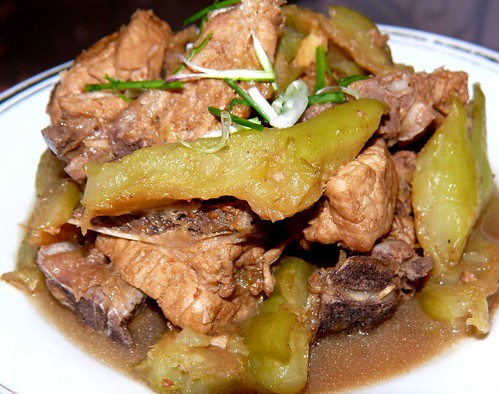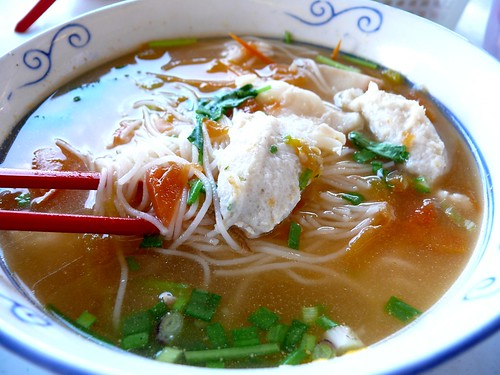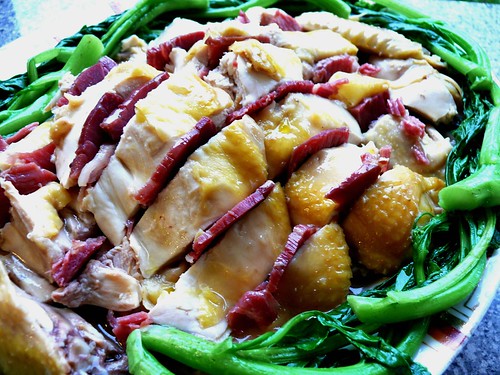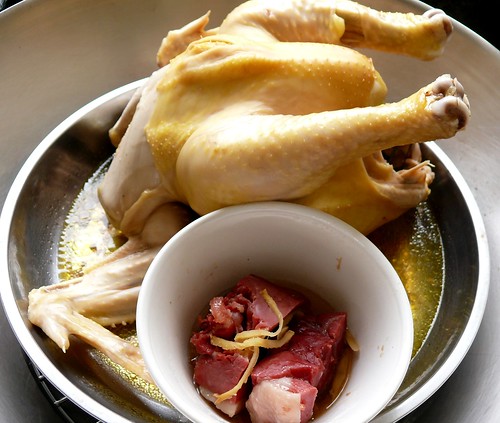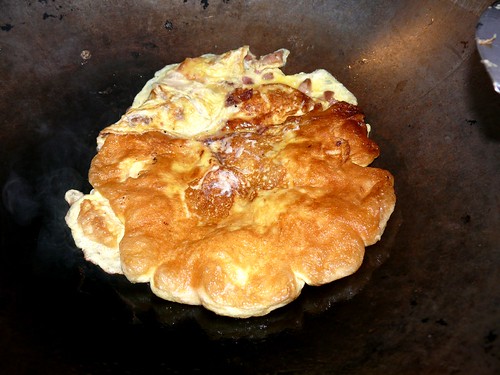
Shuijiao
Those little Chinese dumplings made of wheat-flour wrappers with meat and veg filling inside that are boiled are called shuijiao (water dumplings), while the fried ones are called guo tie, literally meaning pot stickers, which is what they call them in North America. The Japanese stole the recipe but had the courtesy to call it gyoza which probably is their way of pronouncing jiaozi, meaning dumplings which include both shuijiao and guo tie. Right, if you got that, we'll move on.
My MIL makes excellent shuijiao since she's from Shanghai where wheat dumplings of all kinds are eaten. Jiaozi are ubiquitous in Chinese cities from Shanghai up to Shandong to Beijing to Dalien (middle to northern parts of China) and not as common in the southern parts of China. The Chinese students who are studying in our local university always make jiaozi during Chinese New Year. The jiaozi they make are like the ones my MIL make: the wrappers are slightly thicker (as versus Malaysian jiaozi which have very thin wrappers. Nice if it's guo tie, but too flimsy when it's shuijiao) and the filling has more veg and is not dark, which means little or no soy sauce is used. MIL can make hundreds in 2 hours. Her MIL whom I called "Ta Ta" (She was from an era in Shanghai where she'd go dancing with her hub in night clubs while the nanny minded the kids. Up until she died at 94, her eyebrows were pencilled in a fine arch, done by herself every morning. She wore cheong sums and spoke to me in Shanghainese. I love and miss her) and I couldn't keep up with her rolling out of the wrappers. Our job was just to wrap the dumplings up.
Last night I made 150 jiaozi in 3 hours from making the dough to wrapping the jiaozi just to keep myself busy. The boys were eating as fast as I was making them. Hub especially loves it when I make jiaozi because it means he can eat all he wants without me by his side to control him. My mom is another one who's happy because with me so busy, she can dip as much soy sauce as she wants without me rationing her.
Any extra jiaozi can be arranged in a single layer on a sheet of greaseproof paper on a tray and frozen. After that, the frozen jiaozi can be all put into a plastic bag and kept in the freezer without fear of sticking to each other, and they will taste just as good when you cook them straight from the freezer. Thanks to Elaine for these tips. I would recommend that you get a group of friends together and make these dumplings because it's fun and you really need the extra hands. Plus jiaozi are so tasty. The only bad thing is you can eat tons before you realise it. And you'd be eating each other's hand cells.

1. Make the dough by mixing plain wheat flour (Blue/Green Horse is best because wrappers will be very slippery-smooth. You can also use equal portions of bread flour mixed with plain flour) with room temperature water. 900 gm flour to 2 cups water, adding the remaining 100 gm if the dough is too sticky. Knead well until dough is smooth, not sticky but quite firm. If dough it too soft, the dumplings will stick to each other and the dough will not give an el dente bite. If too hard, well, the dumlpings'll just be too hard. Let dough rest for 1 hour, longer if using bread flour mixture. Roll into a long roll of 2 cm diameter (make sure to flour hands and surface) and pull off thumb-sized bits of dough. When my MIL does this, you can hear the 'tuck tuck' sound as she snaps the dough apart. That shows that the dough is pretty firm, which is what you want because if it's too soft, the potstickers will stick to your tray and they will taste soggy after boiling.
Scatter lots of plain flour all over the dough bits.

2. The dough bits are usually rolled on the palms to shape them into smooth balls but it takes quite a bit of rolling to smoothen the creases and flatten into small discs. Leila showed me a faster and no-fail way: twirl the lump of dough round and round (left pic) on the counter with your first 3 fingers, then slam the heels of your palm on the ball of dough to flatten it for the next step. Excellent tip.
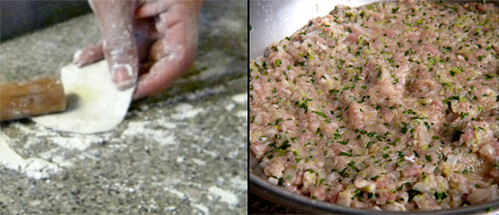
3. Add salt to the fresh pork, then chop it until quite fine. Machine minced meat will be too fine and not give a good bite unless you under-mince it by whizzing and pausing repeatedly. Cut finely Chinese cabbage/wombok/nappa cabbage 1.5 times the weight of the pork (actually no fixed rules on this one. You can add more or less veg as you like; we like more veg) and add salt (1 teaspoon per kg of cabbage) to it. Leave it for 20 minutes, then squeeze as much water out as you can. Add some chopped Chinese chives or leeks if like, then season with some sesame oil, salt, white pepper and cornflour. Add msg like the northern Chinese do, or oyster sauce and light soy sauce but that's what a southern chinese would do to a northern chinese recipe. Best to prepare the filling ahead (upto a day) so it'll be well-marinaded and you won't be hassled last minute.
How do you know if the jiaozi are seasoned well? Do it my MIL's way: make one, boil it, eat it and then adjust the seasoning.

4. Using a short rolling pin (the thin cylindrical pin), roll out the edges of the disks only, turning the piece of dough as you roll so that the middle is thicker, better for holding the liquid from the filling and so it won't break. Do not roll your wrapper too thin or it'll stick to the tray. Put a small amount of filling (too much and it'll not be cooked even when the wrapper goes soft, too little and it won't be tasty) into the center of the wrapper, press the opposite edges together, then make two folds on the edge away from you, one on the left and one on the right, pressing the two edges together as you fold. Make sure it is properly sealed or the filling will run out. It's okay to press real hard on the edges to seal. Make sure you dust the surface of the tray with plenty of flour to prevent the potstickers from sticking onto the surface. It is a good idea to line a piece of plastic over the tray. Place the potstickers well apart so they won't stick. The potstickers can be kept in the fridge (or frozen) until cooking time. Once frozen, you can pack them into containers or bags. They won't stick together. To cook frozen potstickers, take them out of the fridge and cook immediately, do not thaw or they'll stick together.

'Life cycle' of a jiaozi. Notice the wrapper has a thicker center.
5. Boil a pot of water, drop in about 20 to 25 potstickers (depending on amount of water) and cover. When water boils again, add 2 tall glasses of room temp water and cover. When it boils again, let it boil for a minute more (1/2 minute if dumplings aren't too filled). The potstickers will have risen to the top (turn the heat down to see), so just scoop them out.

Guo tie are harder to cook, and most Malaysians prefer the skin/wrapper to be thinner, unlike the authentic guo tie. You have to use a flat skillet, add some oil and fry them over low heat, with some water sprinkled over and cover them so that they are fried and steamed at the same time. Dousing the guo tie with a potato flour-water mixture halfway through will give a crisp layer of pastry around the guo tie, but my results aren't as good so I don't bother. I don't do guo tie often because they are oily to eat and take too long to cook. If I do cook them, I usually cheat by boiling them first and then fry them.
Serve jiaozi with dips: chili-lime-soy sauce, or the more authentic black vinegar and ginger strips/chopped fresh garlic dip. We also love potstickers with Sichuan peppers-chili oil and soy sauce dip. If you like it soupy, and you don't want a too-rich soup, make an instant soup by putting some sesame oil in a bowl, add light soy sauce and a sprinkle of chopped green onions and the boiled potstickers, then pour boiling water into the bowl. There you go, simple but very satisfying food.

